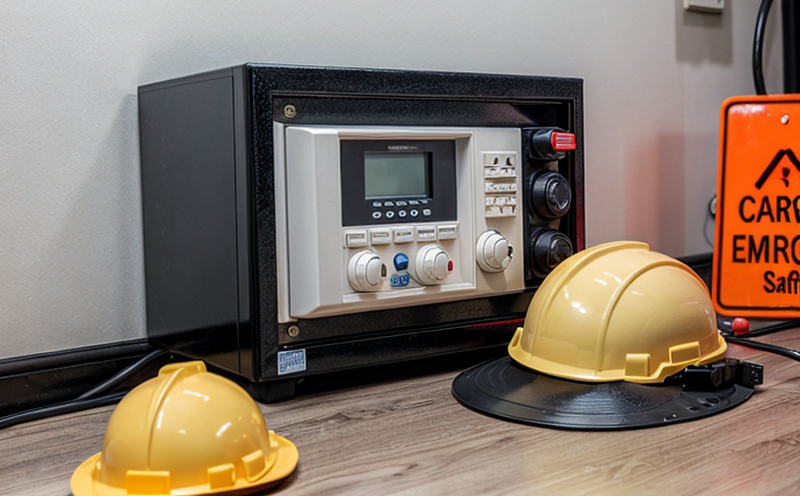ASTM F1478 Emergency Lighting Testing
The ASTM F1478 standard is a critical guideline for ensuring that emergency lighting systems are reliable and effective in aerospace and aviation applications. This testing ensures that emergency lighting systems can perform under extreme conditions, which is essential given the high stakes involved in aircraft safety.
Emergency lighting systems play a vital role during evacuation scenarios, providing critical illumination to guide passengers and crew safely out of an aircraft. The primary purpose of ASTM F1478 testing is to verify that these lights meet all relevant standards and perform as expected under various test conditions. This includes both initial certification tests and periodic requalification checks.
The standard covers a range of lighting systems, from exit signs to cabin emergency lighting strips. It specifies the illumination levels required in different parts of an aircraft during emergencies. For instance, it ensures that the light intensity is sufficient for passengers and crew to navigate safely through various scenarios such as smoke-filled compartments or dimly lit corridors.
The testing process involves several stages, starting with a visual inspection of the lighting system. This is followed by electrical tests to ensure all components are functioning correctly before any environmental stress testing can begin. Environmental stress tests simulate real-world conditions that emergency lights might encounter during an evacuation, such as exposure to water spray or sand.
Once the basic functionality and environmental resilience have been verified, more rigorous performance tests follow. These include illuminance measurements at various points within the cabin, ensuring that light levels are adequate for safe navigation. Additionally, there may be thermal cycling tests to assess how well the lighting systems hold up under extreme temperatures.
The importance of ASTM F1478 testing cannot be overstated, as it directly impacts aviation safety and passenger well-being. In the event of an emergency landing or evacuation, passengers rely on these lights for guidance and direction. A failure in any part of this system could lead to significant delays in evacuation, potentially endangering lives.
Compliance with ASTM F1478 is mandatory for all aircraft operators under relevant aviation regulations such as those issued by the Federal Aviation Administration (FAA) or European Union Aviation Safety Agency (EASA). Ensuring compliance helps maintain safety standards and can prevent costly delays during certification processes. By adhering to these rigorous testing protocols, manufacturers and operators ensure their products meet not only regulatory requirements but also exceed industry expectations.
Why It Matters
The significance of ASTM F1478 emergency lighting tests lies in their role as a critical safeguard for aviation safety. These tests are essential because they provide assurance that the lighting systems will function correctly during emergencies, which could save lives.
- Life-Saving Role: During an evacuation, clear and reliable illumination is crucial for guiding passengers safely to exits. Any failure in this system can lead to confusion and potential injuries.
- Regulatory Compliance: Meeting ASTM F1478 standards ensures that lighting systems meet regulatory requirements set forth by aviation authorities like the FAA or EASA, thereby avoiding penalties and delays.
The testing process is designed to mimic real-world conditions under which emergency lights may operate. This includes exposure to various environmental factors such as water spray, sand, and temperature variations. By simulating these conditions, testers can identify potential weaknesses early on, allowing manufacturers to address them before the product reaches the market.
Moreover, regular requalification checks ensure that lighting systems continue to meet performance criteria over time. This is particularly important given the operational stress that aircraft undergo during flights and ground operations. Regular testing helps maintain consistent quality and reliability, reducing risks associated with aging equipment.
In summary, ASTM F1478 emergency lighting tests are vital for ensuring aviation safety, regulatory compliance, and continuous product performance. They provide peace of mind to operators while safeguarding the lives of passengers and crew in critical situations.
Eurolab Advantages
- Comprehensive Testing Capabilities: Eurolab offers a full suite of testing services tailored to meet the needs of aerospace and aviation clients. Our state-of-the-art facilities ensure that all tests are conducted under controlled conditions, providing accurate results.
- Expertise in Aerospace Standards: With years of experience working with leading manufacturers and operators, Eurolab's team is well-versed in ASTM F1478 requirements. We provide detailed reports and recommendations based on our findings.
Our commitment to quality extends beyond just conducting tests; we also offer consultation services to help clients understand the standards better and implement best practices within their organizations. This proactive approach ensures that all testing is done efficiently, accurately, and in line with industry trends.
We pride ourselves on providing not only robust testing but also valuable insights into how you can improve your products or processes. Our experienced engineers work closely with our clients to ensure they receive the most relevant information possible.
Competitive Advantage and Market Impact
- Enhanced Reputation: By adhering strictly to ASTM F1478 standards, organizations demonstrate their commitment to safety and quality. This enhances their reputation among customers and stakeholders.
- Increased Customer Trust: Meeting these stringent requirements builds trust with end-users who rely on reliable emergency lighting systems during critical moments.
The competitive advantage gained from rigorous ASTM F1478 testing can be significant. It sets a benchmark for excellence that competitors struggle to match, leading to increased market share and customer loyalty. Additionally, compliance with these standards often opens doors to new markets or partnerships, further boosting business growth.
Moreover, maintaining high-quality lighting systems is essential for ensuring ongoing safety and reliability in aviation operations. By consistently meeting ASTM F1478 requirements, companies contribute positively towards overall industry standards, which benefits everyone involved—from manufacturers to passengers.





